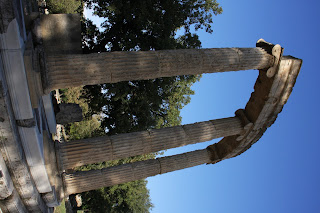Day 5 was the much-awaited visit to Olympia!
My professor guided us as if we were ancient athletes preparing to compete in the Olympic games. He led us through the gymnasium (where athletes competing in the footraces and pentathlon would train for the month prior to the games) and the palaestra (where athletes competing in boxing, wrestling, and the no-rules-bloodbath pankration would train)
We passed into the sanctuary, which held the Temple of Hera (the oldest Greek temple), the Temple of Zeus, a shrine to Pelops (who the games were originally honoring) and...the Philippeion to King Phillip II of Macedonia.
This is of course blasphemy, because Phillip was certainly not a god and therefore did not belong in the sanctuary...but who was going to stop Phillip? He died before its completion, but his son--Alexander the Great--ensured that it was built...no one, it turns out, wanted to mess with him either. (Can you tell that I just had a midterm about the Panhellenic games??)
Here's the workshop of the great Greek sculptor Phidias (who constructed the ivory and gold statue of Zeus which was one of the Seven Wonders of the Ancient World. This workshop was later converted into a Roman basilica...as many things were):


It was especially exciting after having learned so much about Olympia in class, but it's an incredible site regardless of your knowledge.
We passed into the sanctuary, which held the Temple of Hera (the oldest Greek temple), the Temple of Zeus, a shrine to Pelops (who the games were originally honoring) and...the Philippeion to King Phillip II of Macedonia.
This is of course blasphemy, because Phillip was certainly not a god and therefore did not belong in the sanctuary...but who was going to stop Phillip? He died before its completion, but his son--Alexander the Great--ensured that it was built...no one, it turns out, wanted to mess with him either. (Can you tell that I just had a midterm about the Panhellenic games??)
We continued down the path lined with 'zanes' (statues to Zeus bearing the names of those who cheated and were caught...a walk of shame situation), through the vault, and into the stadium:
We were challenged by one of the other CYA groups to a race, and proceeded in the true ancient Greek spirit. My professor carefully announced to all of the runners that "the endline is clearly visible" and left it at that. What he neglected to mention was that there was a Roman end line that's about 20 meters short of the proper Greek end line. Tragically (for those in the other class) and humorously (for those of us in the know), our competitors sprinted through the first end line and did little victory jumps as we dashed past them to the true end. Ancient Greek sportsmanship was all about unfair play as long as it was clever!
Here's the workshop of the great Greek sculptor Phidias (who constructed the ivory and gold statue of Zeus which was one of the Seven Wonders of the Ancient World. This workshop was later converted into a Roman basilica...as many things were):
And a hotel (because every great sporting events needs great accommodation)
And at the Olympia museum...the fantastic pediments of the Temple of Zeus:


Also saw Hermes and the Infant Dionysus by Praxiteles--which I do have a picture of but it is an insult to the artwork, does no justice whatsoever. Suffice it to say it was one of the most perfect sculptures I've ever seen.











No comments:
Post a Comment